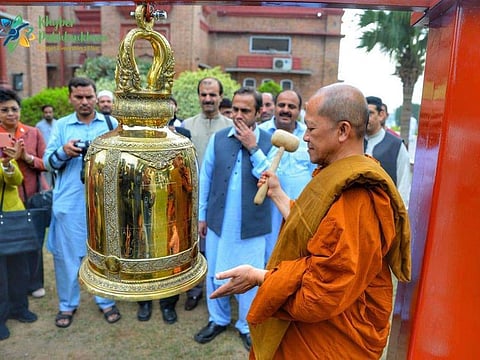Buddhist Monks hope Pakistan can become hub of religious tourism
Buddhist Monks visit historical sites in Pakistan to pray for peace in the region

Islamabad: In the backdrop of the sparkly River Haro, on the grassy hills of Haripur, about 60 kilometres away from Islamabad, sits one of the oldest Buddhist monuments.
After passing the touristy Khanpur Dam, as the destination nears, the ride gets bumpier.
But the air is cooler and the scenes are prettier.
“Welcome to Buddhist remains of Bhamala”, reads a brown signboard glistening in the October sun.
A stony staircase leads up to the world heritage site — the rare and historic Bhamala Stupa.
This was the place chosen by the three chief monks from South Korea to pray for peace in the region.
Senior Buddhist Monk Dr Neung-her Sinim leads a prayer, joined by Monk Jeok Kyung and Monk Jeong Wei, in a ceremony arranged by Pakistan’s Centre for Culture and Development (C2D) and Directorate of Archaeology and Museums.
“Bhamala was chosen for the peace prayer because of its immense spiritual energy. The place holds a great deal of historical and religious importance for Buddhists,” Dr Nadeem Omar Tarar, executive director of C2D, told Gulf News.
Placing his hand on the rubble masonry walls, still standing strong, Dr Tarar said: “These are not ruins. These are our treasures. They must be preserved and cherished by the local people as much as by the government.”
Prayer for peace at Bhamala
The natural surroundings and serenity encircling the Bhamala Stupa, dating back to the 2nd century, offer a strange calmness to visitors. The visiting monks, one swathed in maroon and the other two in saffron robes, began the prayers facing the stupa, the mound-like architectural marvel that houses revered relics. First, the milk was sprinkled on the site to express respect and devotion. Soon, a strange sound from the shaking of a wooden bell alerted the spectators gathered to join the prayer, followed by the rhythmic chants. The visitors, mostly local Muslims, stood in veneration as the monks took their seats on the red cushions neatly placed on the rocky steps of the centuries-old stupa. Dr Neung held an ancient bell in his left hand and a double-headed drum called ‘damaru’ in his right hand, which he turned back and forth while chanting. “All these sounds combined create vibrations to replace negative energy with positive ones,” described Dr Esther Park, head of Gandhara Art and Culture Association.
Why is Bhamala Stupa so sacred?
Describing his experience of meditation at Bhamala Stupa, Reverend Monk Dr Neung, told Gulf News: “Pakistanis and the world must realise the significance Bhamala holds for the spiritual community. Our ancestors chose this place. This is why we pray here for peace in the region and the world.”
Declared a world heritage site in 1980, along with other places in Taxila valley, Bhamala witnessed its first excavation in 1930, which was later resumed in 2012 and 2014 under the supervision of Khyber Pakhtunkhwa (KP) Archaeology and Museums Director, Dr Abdul Samad.
The latter project brought to light a number of sacred artefacts such as stucco Buddha statues, terracotta tiles, coins, iron and copper objects as well as structural remains of a subsidiary stupa and chapels. The most remarkable discovery, however, was a centuries-old 14-metre long Buddha statue that dates back to the third century, making it the world’s oldest ‘sleeping Buddha’ statue, predating such statutes reported in India, China, Afghanistan, Tajikistan, Kyrgyzstan.
Thailand Monks visit Pakistan peace
Pakistan seems to be continuously haloed by spiritual Buddhist leaders. This week, Thailand’s chief monk arrived with a 15-member delegation to tour the historical Buddhist sites.
Thai Monk, Most Venerable Arayawangso, also called on Pakistan President Dr Arif Alvi in Islamabad as well Foreign Secretary Sohail Mahmood.
“Pakistan is proud of its multicultural heritage, which has been assiduously preserved and promoted as the shared heritage of mankind,” remarked the foreign secretary, hoping the visits would strengthen spiritual linkages between Pakistan and Thailand that go back to Gandhara civilisation.
Installing a ‘Bell of Peace’ at the Peshawar museum, the Thai Monk rang the bell five times and announced,
“This sends a message to the world that peace existed on the land of Pakistan” and “This will be a gateway to peace and harmony.”
Pakistan — a hub of religious tourism
Often called the “cradle of civilisation,” ancient Pakistan was home to centuries-old civilisations like Mehrgarh (6500 to 2500BC), Indus Valley (2500 and 1700BC) and the Gandhara (530BC to 1021AD), making it a revered destination for the followers of three major religions, Buddhism, Sikhism and Hinduism. The country, however, lost many of the precious artefacts due to antiquities smuggling and also government’s negligence. This has now changed. Promoting cultural heritage and religious tourism is close to the heart of Pakistan’s Prime Minister Imran Khan as the current government has dedicated efforts to preserve heritage sites.
How is Pakistan promoting religious tourism?
Pakistan’s KP province houses more than 6,000 historical sites and Peshawar Museum is said to have one of the world’s biggest collections of Buddhist objects. “The followers of Buddhism would find a treasure trove of Buddhist statues and heritage after thorough research and revival of the sites,” vowed the reputed archaeologist Dr Samad. KP government is spending Rs1 billion to protect ancient Buddhist sites to attract foreign tourists and researchers after the improved security situation, he said.
As a Buddhist trail of religious sites is being developed in KP and Punjab, Pakistan is all set to open its doors for Sikh pilgrims on November 9, connecting Pakistan and India via a visa-free Kartarpur Corridor. Such initiatives will make Pakistan “a major religious hub” for the Sikh and Buddhist community, says PM Imran Khan, and would also boost the local economy and travel and hospitality sectors.
Sign up for the Daily Briefing
Get the latest news and updates straight to your inbox



